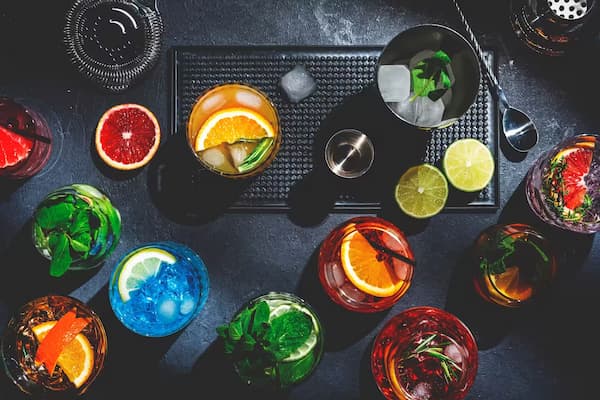Basil leaves
With Basil leaves you can make
Agave Verde
Gin Basil Smash
Gold Cup
Ace Royal
Cotswold Basil Smash
Golden Smash
Mango Basil Margarita
Clementine Gimlet
Awaiting Grace
We've got 17 cocktails that can be made with Basil leaves.
Find out what to make with Basil leaves
Q&A
What is the historical significance of basil leaves in cocktails and mixology?
Basil, belonging to the mint family, has a rich history that transcends culinary boundaries into the world of mixology. Originating from tropical regions in Asia and Africa, it has been cultivated for over 5,000 years. While primarily recognized in culinary traditions for its aromatic and flavorful contribution to dishes, basil's entry into cocktails and mixology is more recent. Its aromatic fragrance and slightly anise-like flavor that adds depth to cocktails have made it a staple in modern mixology. Its historical use in medicinal and ceremonial practices has translated into a symbol of hospitality and elegance in cocktails, showcasing the herb's versatility and cultural significance across different eras.
What are the best substitutes for basil leaves in cocktails if I don't have any on hand?
If you find yourself without basil leaves for your cocktail, several alternatives can mimic its fresh, herbaceous profile. Mint is the closest relative and a suitable substitute, offering a similar refreshing quality. Other herbs like cilantro or parsley can provide an interesting twist, though with distinct flavor profiles. For a touch of sweetness akin to sweet basil, consider a small amount of tarragon. Remember, the goal is to maintain the cocktail's balance of flavors, so start with smaller amounts and adjust to taste.
How can I use basil leaves to garnish my cocktails in a visually appealing way?
Basil leaves make a visually stunning garnish, enhancing the overall appeal of your cocktails. For an elegant touch, add a fresh basil sprig to the glass; its vibrant green adds a pop of color. You could also slap a basil leaf between your hands before placing it on the drink to release its aromatic oils, enhancing the sensory experience. For a more intricate presentation, layer basil leaves with berries or citrus slices on a cocktail skewer. Always choose fresh, bright green leaves for the best visual impact and aroma.
What are the best techniques for muddling basil leaves in cocktails to maximize flavor without causing bitterness?
To extract the maximum flavor from basil leaves without introducing bitterness, the key is gentle muddling. Use a cocktail muddler or the back of a spoon to lightly press the basil leaves against the bottom of your mixing glass. The goal is to bruise the leaves sufficiently to release their essential oils, not to shred them. Over-muddling can break the leaves into small pieces, leading to a bitter taste and green flecks in your drink. A few gentle presses are usually enough to impart the desired aromatic and flavor qualities into your cocktail.
Can basil leaves be used in non-alcoholic cocktails, and if so, what are some recipe ideas?
Absolutely, basil leaves are a fantastic addition to non-alcoholic cocktails, lending their fresh, herbal notes to a variety of drinks. One popular option is a Basil Lemonade, made by muddling basil leaves with lemon juice and simple syrup, then topping with sparkling water. Another refreshing choice is a Cucumber Basil Mocktail, mixing muddled basil and cucumber with lime juice and soda water. These drinks showcase basil's versatility and ability to elevate even non-alcoholic beverages with its vibrant flavor and aroma.
Ingredients like Basil leaves
Other Kitchen cupboards
How it works
Easily create your bar from the ingredients you have at home, and we'll show you what you can make with the ingredients you have to hand.
Once you've added this ingredient head to your My bar page and fill up everything else you have.
We'll also show you cocktails that can make by substituting what you have for one of the ingredients you don't, riffing on the original. Now go forth and create something delicious!

















































